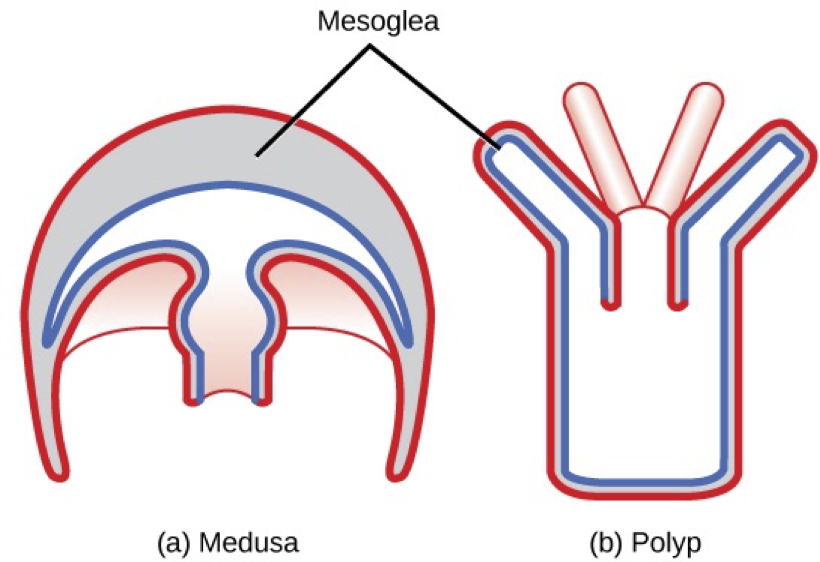Basal Animals: Poriferans and Cnidarians
Along with ctenophores and placozoans, sponges and cnidarians do not fit into one of the major clades of bilaterian animals. They are sometimes referred to as basal animals, reflecting their phylogenetic position at the ‘base’ of the animal tree. Unlike the protostomes and deuterostomes, they do not have three embryonic tissue layers or bilateral symmetry.
Poriferans
Sponges, or poriferans, are almost unique in being animals that do not possess true tissue. However, they do have cell types that perform specialized functions. The reason that we do not call these tissues is that sponge embryos do not undergo gastrulation during development. Therefore, the cell types are not homologous to the germ layers – endoderm, ectoderm, and mesoderm – of other animals.
Sponge cell types include the pinacocytes, choanocytes, sclerocytes, amoeboctyes, and others. The pinacocytes form the outer wall of the body, a protective layer dotted with pores. Choanocytes line the inner cavities of the sponge. They are flagellated and beat their flagella produce a current. Water enters through ostia, or pores in the outer body wall, and exits through the osculum (or oscula, if the sponge has multiple excurrent openings). Between the outer and inner layer is an acellular material called the mesohyl. It is inhabited by cells such as sclerocytes, which secrete calcium carbonate or silica to make spicules, and the amoebocytes, which move through the mesohyl to deliver food to other cells. The amoebocytes also function as the stem cells, and can differentiate into other cell types.
Sponges obtain food by phagocytosis of bacteria and other small particles. Digestion is therefore intracellular, unlike most animals. Sponges can reproduce sexually or asexually. Sponges are monoecious, but often display sequential hermaphroditism, meaning that they do not produce eggs and sperm at the same time. This prevents self-fertilization.
There are over 8,000 described species of sponges, currently arranged within four classes. Sponges are known in the fossil record as early as 580 mya, from the Doushantuo Formation. Placement of sponges in the animal phylogeny has been controversial for years. However, a recent phylogenetic analysis that used 1,719 genes in 97 species[1] supports the monophyly of sponges, and their position as a sister group to all other animals.
Cnidarians
Cnidarians are diploblastic animals with radial symmetry. Cnidarians exist in one of two body plans – polyp or medusa – and some cnidarians alternate between these during their life cycle. Both body types are lined on the outside by epidermis (which develops from the ectoderm of the embryo) and on the inside by gastrodermis (which develops from endoderm). Between is an acellular jelly-like layer called mesoglea.

Cnidarians have a distinctive cell types specific to the phylum. Cnidocytes are the stinging cells that cnidarians use to capture prey and defend themselves from predators. The cnidocytes are located around the mouth/anus and on the tentacles, and discharge specialized organelles, called nematocysts. The nematocyst is explosively discharged from a cnidocyte when the cell detects touch. Nematocysts are discharged at accelerations of over 40,000g
(and possibly more than an order of magnitude above this).[2] Cnidarians have a simple nervous system, including sensory neurons, interneurons, and motor neurons, arranged in a nerve net that is distributed throughout the body. They have a single opening to the digestive cavity, which serves as both mouth and anus.
There are over 10,000 described cnidarian species, which are divided into four classes.
- Class Hydrozoa – siphonophores, Portuguese man o’ war, Hydra, Obelia, etc.
- Class Scyphozoa – jellies/jellyfish
- Class Cubozoa – box jellies
- Class Anthozoa – corals, sea fans, sea pens, sea anemones
[1] Simion et al. (2017). A large and consistent phylogenomic dataset supports sponges as the sister group to all other animals. Current Biology 27, 958–967
[2] Nüchter et al. (2006). Nanosecond-scale kinetics of nematocyst discharge. Current Biology 16, R316-R318.

